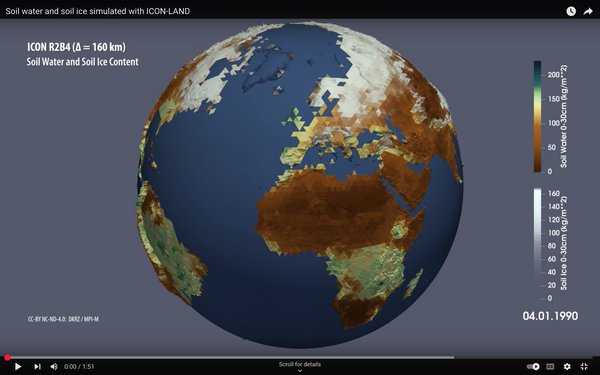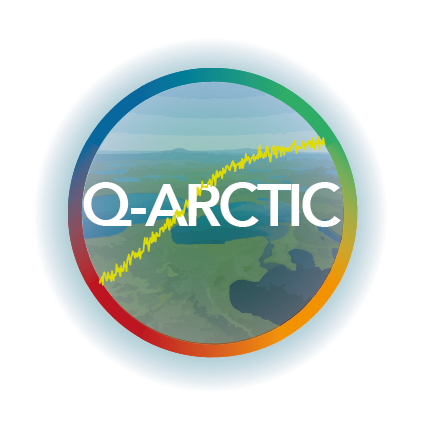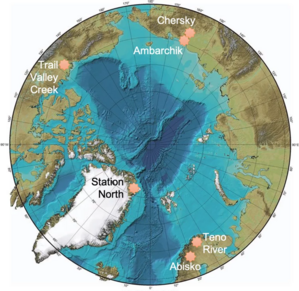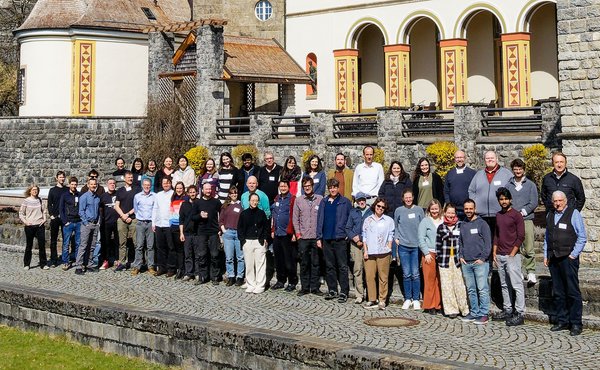Landsurface remote sensing
Remote sensing activities in Q-Arctic focus on characterisation of wetness gradients covering a range of aspects. Most prominent in permafrost landscapes are lakes, but wetlands are very common as well. Spatial heterogeneity is high along temporal variability. Water redistribution is often trigged through disturbances. Patterns of wet-dry gradients and short term dynamics (within satellite observation period) are quantified through novel approaches and datasets for Q-Arctic. Traditionally this is addressed via landcover and/or terrain as proxy. Microwave observations can potentially provide additional information through representation of dielectric properties, surface roughness and surface deformation resulting from thaw. The combination of different methods/sensors yields large potential to gain knowledge on underlying processes and to advance upscaling of in situ observations.
Permafrost modelling using ICON
Soil water and soil ice simulated with ICON-LAND
This animation showcases results from a simulation using the ICON-LAND model at a coarse resolution of approximately 160 km. A key feature of this simulation is the use of HydroTiles, an innovative infrastructure that divides each grid cell into distinct hydrological regimes, each with its own water and energy storage systems. These tiles respond individually to atmospheric conditions and can exchange water laterally based on a predefined flow hierarchy. The simulation was carried out on DKRZ's Supercomputer "Levante" and was funded by the European Research Council (ERC) under the European Union’s Horizon 2020 research and innovation program (grant agreement No 951288, Q-Arctic). It is visualized using the software ParaView. Simulation: Tobias Stacke, MPI-M (https://mpimet.mpg.de) Visualization: Michael Böttinger, DKRZ (https://www.dkrz.de)

Fieldwork
Field work activities within Q-Arctic focuses on monitoring greenhouse gas and nutrient cycle processes within different Arctic ecosystem types to study their spatio-temporal variability across environmental gradients, and their relationship to environmental controls. Observation sites are distributed across several Arctic regions. Two sites in Russia are currently inaccessible, but legacy instrumentation is still in place, and operational. The current focus of field work within Q-Arctic is therefore mostly focused on Canada and the European Arctic, where work at several new locations have been established since 2022.
| Site | Description | Measurements |
| Abisko (Sweden) | The Stordalen Mire is a palsa mire complex underlain with sporadic permafrost located in northern subarctic Sweden (68° 200 N, 19° 300 E), 10 km east of Abisko Research Station. | Flux chamber work focusing on nutrients and carbon, drone observations of carbon flux patterns. |
| Station North (Greenland) | Station North, also called Villum Research Station, is a research facility at a military outpost in high arctic North Greenland (81°36’ N, 16°40’ W). Observations are part of the European ICOS observation network. | Automated flask measurements of atmospheric trace gas species (since 2019). |
| Teno River (Norway) | The Teno River is located at the northern border between Finland and Norway and flows along the community of Utsjoki (69°54'38.7"N 27°01'51.6"E). | Campaign with floating chambers to constrain spatial variability of riverine carbon effluxes. |
| Trail Valley Creek (Canada) | The Trail Valley Creek research station (68.74 °N, 133.50 °W) is situated near the treeline in the continuous permafrost region close to Inuvik within the Canadian Northwest Territories. | Flux chamber measurements in terrestrial and aquatic ecosystems, drone observations of carbon flux patterns. |
| Ambarchik (Russia) | Ambarchik (69.62N, 162.30E) is a weather station operated by the Russian meteorological service, situated on the coast of the Arctic Ocean near the mouth of the Kolyma River in Northeastern Siberia. | Continuous monitoring of well-calibrated atmosphere greenhouse gas mixing ratios (since 2014). |
| Cherskii (Russia) | The Ambolikha site (68,61N, 161,34E) is situated on a floodplain of the Kolyma River about 15km south of the city of Chersky in Northeast Siberia. | Monitoring of atmospheric fluxes with different systems, drainage disturbance experiment (since 2013). |
Permafrost-Cloud Feedback MIP
General Hypothesis
Landscapes in the Arctic and subarctic zone are often very wet with water saturated soils and an extensive lake- and wetland cover shaping the moisture and energy exchange with the atmosphere. This, however, is likely to change in a warmer future. Here, the hypothesis is that a thawing of the ground predominantly leads to a lowering of the water table and an increase in hydrological connectivity. This causes a drying of the near-surface soil layers which, in turn, limits evapotranspiration and reduces the summertime cloud cover. The reduction in cloudiness increases the amount of radiation absorbed at the surface, thus, temperatures and thawing rates.
Target of the investigation
In our recent investigation with the ICON Earth system model (de Vrese et al., 2024) we found that such a positive feedback indeed exists. Furthermore, our simulations suggest that the impacts on surface temperature are not limited to the Arctic and sub-arctic zone, but notably increase the global mean temperature. In case of our high-warming scenario by an additional 0.25°C. However, the overall response of the high-latitude hydrological cycle to rising temperatures is still dominated by factors other than changes in the soil hydrological parameters. This makes it extremely difficult – if not impossible -- to isolate the respective effects in the output of existing simulations. Thus, an assessment of the global-scale impact of the permafrost cloud feedback requires simulations that directly target the effects due to changes in hydrologic connectivity.
Project Meetings of the Q-Arctic Working Groups
| Event | Description | Date | Location |
| Q-Arctic Ringberg Workshop (Agenda) | Mar 26 - 29, 2025 | Schloss Ringberg, Bavaria, Germany |
| Q-Arctic annual project meeting 2024 | Oct 7 - 9, 2024 | Max Planck Institute for Meteorology, Hamburg, Germany |
| Q-Arctic annual project meeting 2023 | Oct 23 - 25, 2023 | b.geos, Korneuburg, Austria |
| Q-Arctic annual project meeting 2022 An overview of the program can be found here. | Nov 14 – 16, 2022 | Max Planck Institute for Biogeochemistry, Jena, Germany |
| Q-Arctic Kick-Off meeting 2021 | Nov 15 - 17, 2021 | Max Planck Institute for Meteorology, Hamburg, Germany |






